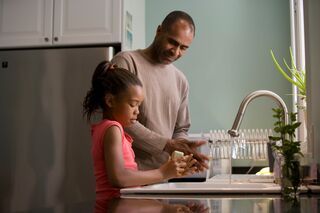Resilience
Fostering Resilience in Children During a Pandemic
Five ways to cultivate hope and resilience in your children during COVID.
Posted January 29, 2021 Reviewed by Ekua Hagan
This guest piece is written by Dr. Pamela Davis.
With the COVID-19 pandemic raging around us and hospitalizations on the rise, mandated lockdowns are again a reality. It has been a long 10 months of thwarted plans, virtual schooling, and social distancing, causing many families to feel on the brink of crumbling. While children are typically incredibly resilient, they do tend to follow the lead of their caregivers. Knowing this, there are some things parents can do to foster resilience in children during challenging times.

Remind them that they can do hard things
It can be helpful to remind children that living through this pandemic is a very hard thing, but they have done hard things before. Spend some time remembering together other things that have happened outside of their control and how they handled those things. This hard thing will eventually pass and not feel so hard. Remind children that it’s a lot easier to do hard things when we have other people helping us. On our own, we cannot conquer this pandemic, but together we are stronger. This certainly isn’t the last hard thing that our children will have to face in life, but this hard thing can build strength to handle other hard things that come.
Welcome grief along with hope
Sometimes in our desire to hold hope and stay positive for our children, we unintentionally bypass the deep grief that has been a marker of this pandemic. Instead, consider finding ways to help children acknowledge the losses and express their sadness. Some have lost family members or friends to the pandemic, and these big losses are often easily identified. But the loss of comforting rituals—such as visiting with friends and grandparents, going to school and church, playing on a sports team, or going on vacation—is easier to skip over. Instead of thinking about grief and hope as opposites, help children integrate these two ideas together. As we hold grief and hope together, we help children process their losses in a way that produces growth.
Create a storybook and develop new rituals
One way to assist children to hold grief and hope together is to create a storybook about their experiences. For example, they might draw or paint pictures about what celebrating Christmas or going to school used to be like before the pandemic and what those things are like now. Then have them pretend that the pandemic is over—because truly, that day is coming—and imagine what their life will be like in the future.
Another way to assist children to integrate grief and hope is to develop new rituals. Certainly, this includes using virtual visits in place of in-person visits, but also consider going beyond just virtual substitutes. For example, perhaps the time previously scheduled for soccer team practice could be replaced with playing a family game, every week at the same time. Or you might schedule a weekly baking time during the time that your child used to play with friends. The key here is to create some new rituals for your family, in addition to re-shaping old rituals virtually. Incorporating rituals can provide stability for children and remind them that they are safe.
Limit exposure to media and the news
Children absorb much of what is going on around them, even when we think they are unaware. Pay attention to what children might be overhearing as you talk on the phone or listen to the news. For children with access to tablets and smartphones, ensure that they are not able to access news reports or social media feeds that can be tinged with doom and gloom. This idea is helpful for both children and adults. Since children tend to mirror their caregivers, they easily take on the stress and anxiety that the important adults in their lives are holding. Consider taking a few days or a weekend off from any exposure to media and the news.
Remember that COVID-19 is a trauma for children and for you
Many experts acknowledge that COVID-19 qualifies as an Adverse Childhood Experience (ACE) and so we should expect responses typical to a traumatic event. Some children might react with behavioral changes, difficulties with self-regulation, intense emotional responses, or an inability to do simple tasks or complete schoolwork.
What is unique about this pandemic is that it is a shared trauma, meaning that children and their parents are experiencing it simultaneously. Shared trauma creates unique opportunities for bonding during the hard experiences, but shared trauma also carries the possibility that children will flounder if their parents are floundering. For this reason, it’s important that caregivers find healthy outlets (such as with adult family or friends or a counselor) to process their own experiences. One of the best ways that parents can help their children during this time is to find help for their own grief and trauma.
Summary
Finally, remember that children gain much from being in the presence of a safe caregiver. Safe adults assist children to ride the wave of even the most dangerous storm and emerge stronger and more ready to face the next hard thing. As we help our children hold grief and hope together and remind them that they can do hard things, we produce opportunities for growth and we create positive opportunities to bond with our children that we never imagined.

About the Author: Pamela S. Davis is an associate professor and the Director of Graduate Programs in Counseling at Gordon-Conwell Theological Seminary in Charlotte, NC. She has a Ph.D. in Counselor Education and Supervision from Regent University and is a licensed mental health counselor in North Carolina, South Carolina, and Illinois. As a Registered Play Therapist Supervisor, Dr. Pam is passionate about training the next generation of mental health professionals to serve children and to understand how theology shapes counseling. She is quite fond of yoga, church, kayaking, and pour-over coffee.




